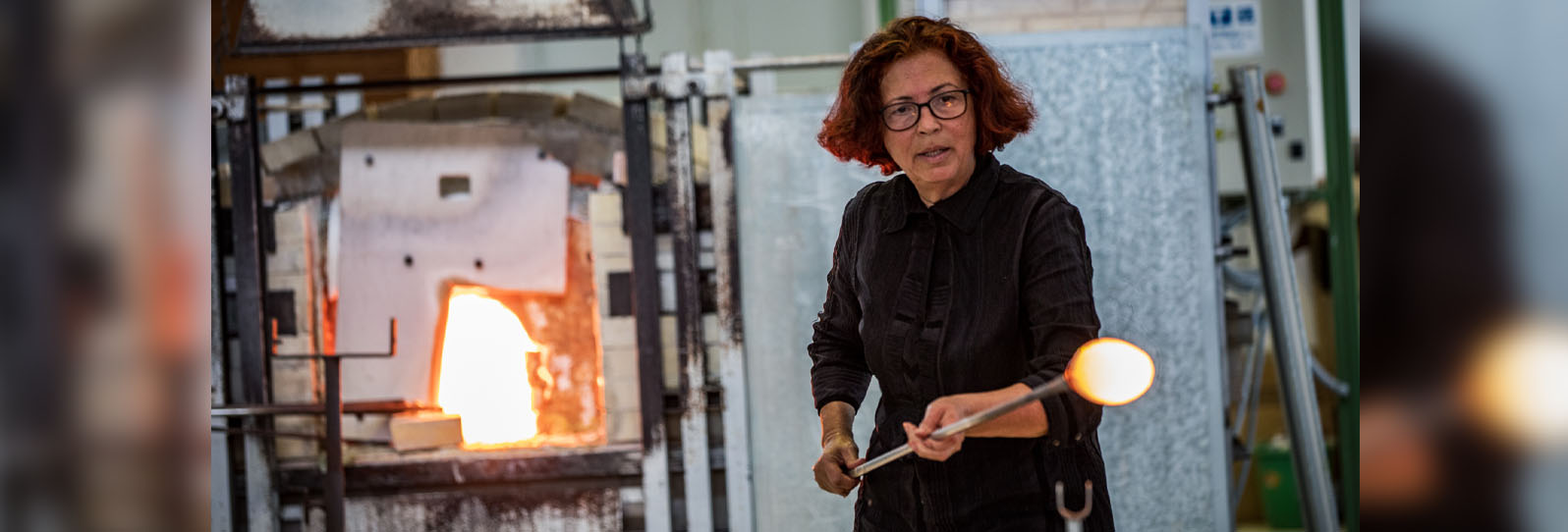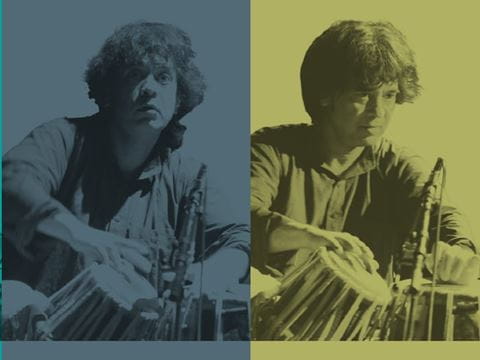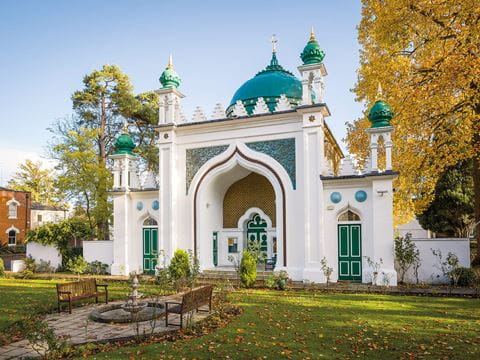
Reviving the Art of Tunisian Glass
In the mid-1980s, Sadika Keskes fired up the first artisanal glass furnaces in Tunisia in 600 years. Since then she has revived a once-thriving heritage craft and, through her teaching, lit up imaginations among a new generation of artisans.
As a rumbling furnace fires up, glowing orange at 1,500 degrees Celsius, Sadika Keskes blows through a long, thin metal pipe to gradually inflate a hot, heavy bubble of molten glass. Slight, spry and focused, she moves from the furnace flames to a nearby water-cooling basin and back to the furnace to continue shaping her glass creation. She continues working it, blowing, turning and reshaping the translucent, pliable recycled glass with jacks that resemble oversized tweezers, her delicate touches and breaths guiding each movement.
In Gammarth, Tunisia, where Keskes operates her shop, SADIKA, many know her simply as the glassblowing master and—for some of her larger projects—an architect of light. But perhaps most importantly for her country and the wider North African region, she’s the pioneer of her country’s glassblowing revival, and she has secured its techniques for future generations.


“I am a woman who likes the fire—its beauty, its atmosphere,” says Keskes, 61, keeping her gaze fixed on the turning, glowing globe of glass. “It reflects my personality a bit.”
Glassmaking started in Tunisia shortly after the arrival in the ninth century BCE of the Phoenicians, who inhabited much of the eastern Mediterranean coast and dominated maritime trade for centuries until eclipsed by Rome. Until their invention of pipe-blown glass in the first century BCE, the glass they produced was solid, much like the glass also produced for centuries in Sumeria and Egypt. Both forms of glassmaking were advanced in the Phoenician city of Carthage, whose ruins today are just a few kilometers from Keskes’ workshop.
In Europe glassblowing became popular and highly refined in Venice, particularly on the nearby island of Murano. There it was so lucrative that, in the 13th century CE, Venice passed laws restricting foreigners from learning the trade—which the Venetians had learned from Syrians—and glassblowers from traveling abroad. By the 14th century, in Tunisia glassblowing had almost completely died out. It took six centuries, and Keskes, to literally breathe new life into the craft.
“I am a woman who likes the fire—its beauty, its atmosphere. ... It reflects my personality a bit.”
—Sadika Keskes

“I wanted to rediscover the past in order to inform our present,” she says, mentioning her introduction to glass began more than 40 years ago. “So I went in search of our history with this luminous material, this magical carrier of light.”
Keskes was barely a teenager when she won a top prize at school for clay sculpture. Her father, Bechir Keskes, a master carpenter, and her mother, Aichoucha Bouricha, a pianist, encouraged each of their children—Keskes has 11 siblings—to explore many art forms. So, she says, she always felt free to pursue artistic interests.
Soon after the school competition, she says, “I saw a documentary about glassmaking. It captured my imagination—the colors, the movement of the molten glass. The glow of the fire simply fascinated me,” she says. The experience stuck with her, and “from that day I was determined to be a glassmaker.”
Awarded a scholarship to Italy as a teenager, she set out in 1980 to Venice to learn from masters there. Later, in Tunis, she trained with glassblowers from Czechoslovakia (now the Czech Republic and Slovakia), where Bohemia crystal remains some of the best in the world.

In Italy, she says, “I found the historical link between Murano glass and Phoenicia on many levels. What made Venetian-Murano glass so special is that it used local quartz pebbles, which are ground very finely and combined with soda as known as Levantine soda ash.” The quartz in Murano produced nearly pure silica sand, which lends glass its clarity. The Venetians, she adds, kept a monopoly on soda ash from the Levant until 1592.
“This meant that the Murano-Syria connection was twofold. Both the initial know-how brought by Aleppo merchants to the Roman Empire at the end of the first century, as well as the raw materials [that] originated in the Middle East.”
Keskes immersed herself in both Italian and Slavic blown-glass traditions while also pursuing understanding of Tunisia’s own history with glass. In 1984, amid what became a seven-year teaching stint at the Tunis Institute of Fine Arts at Nabeul, she established an artisanal glassmaking workshop: It was, she says, “the first one in 600 years” in Tunisia.

Nearly a decade later, Keskes opened SADIKA in Gammarth, along the coast not far from the historic ruins of Carthage. Since its opening she has trained more than 200 young artisans and created initiatives to support them. Today some former students teach her techniques to their own students.
While Keskes was reestablishing glassmaking in Tunis in the 1980s and 1990s, a kindred movement had been taking root in the US. The Studio Glass Movement, inspired from a series of 1962 workshops at the Toledo Museum of Art in Ohio, was also reviving artisanal glass in North America.
“It’s a type of cottage industry of hand-blown and -made glass that is produced in a limited series or as a unique piece,” explains glass scholar Bill Gudenrath, a resident advisor at the Corning Museum of Glass in New York.
“Artists actually do the work themselves as opposed to designing and having factory workers or technicians do the work.”

Gudenrath is also a glassblower, instructor and author, recognized internationally as an authority on early glassmaking techniques up to the 18th century. His research focuses on how glass is made, and he enjoys his self-identification as a “glass detective.”
He understands the impact of Keskes’ contributions to Tunisian glass arts.
“It is clear to me that Sadika, perhaps unknowingly, is part of this international community of glassmakers,” he says.

For Keskes, her love of glass was also related to a personal journey of self-discovery, of learning about her own heritage as well as the contributions to the arts of glass from artisans over centuries from the greater Middle East. For nearly two decades, Keskes set out to research how glass was made throughout Mesopotamia, Pharaonic Egypt, Phoenician Byblos, and later closer to home in Carthage, today a suburb of the nation’s capital Tunis and a designated UNESCO World Heritage Site.
A turning point in her research came while investigating crematory furnaces discovered in Phoenician cemeteries in the Carthage area. In some she found remains of glass “dough”—indications that the furnaces were also used for glassmaking.

“I began replicating the Phoenician-Carthaginian furnaces, and I made glass in the Carthaginian way,” she says.
One early Phoenician method of glassmaking involved pouring glass into metal mold, she explains. Carthaginians employed a different method that used a pole with a solid object on its end, “which we call the ‘heart,’ and the glass is wrapped around it until it is completely covered by glass before being put into the furnace,” she says.
Kerkouane was one of the early Carthaginian cities, and its necropolis is a designated UNESCO
World Heritage Site because the cemetery holds the only surviving Phoenicio-Punic remains. Keskes also learned that glass objects and beads had been discovered in Kerkouane graves of early, high-ranking officials. Resting sites of priests, she says, would often contain gold, too, as well as other objects of value.
“Glass was among the possessions we found. At the time it was considered as precious as diamonds are today,” says Keskes, explaining how she discovered remnants of gold in the glass furnaces. “The furnaces were used to melt gold and make glass—this gave the glass a very unique color.”

Her research helped her attain in 2019 the seat of vice president for the UNESCO International Fund for the Promotion of Culture, a post she says has increased her understanding of the significance of the history of glass in the region, and the use of color in particular, which can help identify a piece’s origins. For example, some glass colors were made with gold, while others, such as blue, were made from silver, and still others from a variety of other minerals—often highly localized.

Christine Tarkowski, a professor in the Fiber and Material Studies Department at the Art Institute of Chicago, points out that, for example, blues in glass are only found in Afghanistan, while other colors could be attributed only to Phoenicians.
“It has this ability to locate color because of the minerals in a specific place,” Tarkowski says.
Before glassblowing was discovered in the first century BCE, glass was semiopaque, cloudy, and contained bubbles, striations and sometimes poorly molten bits of minerals. It often resembled ceramics rather than what most think of as today’s clear and vibrantly colored glass. It was glassblowing that also, in time, helped glass become more widely available and affordable.
Gudenrath notes that “glass as a material for windows coincided with the development of glassblowing” and that it has been in use in the Roman world since the end of the first century CE.
One of Keskes’ proudest moments came in the mid-1980s when she opened the Tunisian School of Glassmaking.
“One of the things that makes our school unique is the way we combine metal and glass,” she says.
Many of Keskes’ vases, lamps and candle holders are reminders of this combination. Her table and kitchenware creations are even at times throwbacks to the preglassblowing era, showcasing a sparkled and cracked design created by dipping the glass into water before putting it back in the furnace.
Since then more than 30 glassmaking workshops have launched in Tunisia as a result of her teaching. On average each workshop employs 15 to 20 people, and several students have ventured into teaching too.
Assad Dghim, whom Keskes taught in 1987, is the sole glassmaking trainer at the Tunis Institute of Fine Arts at Nabeul, where Keskes once taught, and he has been passing along his former instructor’s expertise since 2000.

“Glassmaking with Sadika was about passion and beauty,” Dghim says. “We endured the enormous heat and honed our own agility.”
Beyond the furnace and precision of shaping glass, Keskes says glassblowers are tethered to their appreciation and respect for light.
“Nowhere does this intangible become more tangible than with glass. Glass absorbs light and reflects the light at the same time,” she says, underscoring how light changes with every second. “When I completed entire surfaces with glass, I realized that there was such a thing as an architecture of light.”
Some of her work has also included glass floors, mosaics, and ceilings in public buildings, and even a glass chalet hotel project. Her most recent dream is to design a school in Tunisia dedicated solely to teaching glass architecture where grand glass constructions can feature the many prismatic colors of light.
With all her contributions to reviving artisan glass in her country, she says there is still much more to do, much more to create.
“I like a challenge—new things—things with movement and the transient,” she says. “Glassmaking is a big challenge, and I like the challenge.
About the Author

George Azar
George Azar is author of Palestine: A Photographic Journey (University of California, 1991), co-author of Palestine: A Guide (Interlink, 2005) and director of the films Beirut Photographer (2012) and Gaza Fixer (2007). He lives in Beirut.
Mariam Shahin
Filmmaker and writer Mariam Shahin has produced and directed more than 70 documentary films, and she is author of Palestine: A Guide (Interlink Books, 2005) and coauthor of Unheard Voices: Iraqi Women on War and Sanctions (Change, 1992).
You may also be interested in...

Zakir Hussain Played Tabla in Indian Classical Music and Beyond
Arts
While mastery of Indian musical traditions is one clear accomplishment, the late Zakir Hussain’s bold pursuit of his art across genres likely best defines his legacy.
Rediscovering Voices and Stories: A Conversation With the Editors of Muslim Women in Britain
Arts
When Sariya Cheruvallil-Contractor embraced Islam as a teen, she recognized a divide between her faith and its portrayal in some Western media in the 1990s. Determined to challenge stereotypes, she became a sociologist dedicated to what she sees as Islam’s empowering principles for women.
Smorgasbords of Andalusi and Mahgribi Dishes, a Conversation With Food Historian and Author Nawal Nasrallah
Arts
In Smorgasbords of Andalusi and Mahgribi Dishes, Arab food historian Nawal Nasrallah breathes new life into an anonymously compiled 13th-century cookbook.